The HPE ProLiant DL320 Gen11, a single-processor, 1U server, is engineered to offer an optimal blend of flexibility, density, and cost-efficiency, making it a formidable choice in the modern computing landscape. Traditionally aligned with ROBO (Remote Office/Branch Office) and small edge deployments, the DL320 family steps up its game with the latest iteration, introducing some unexpected enhancements that expand its applicability.
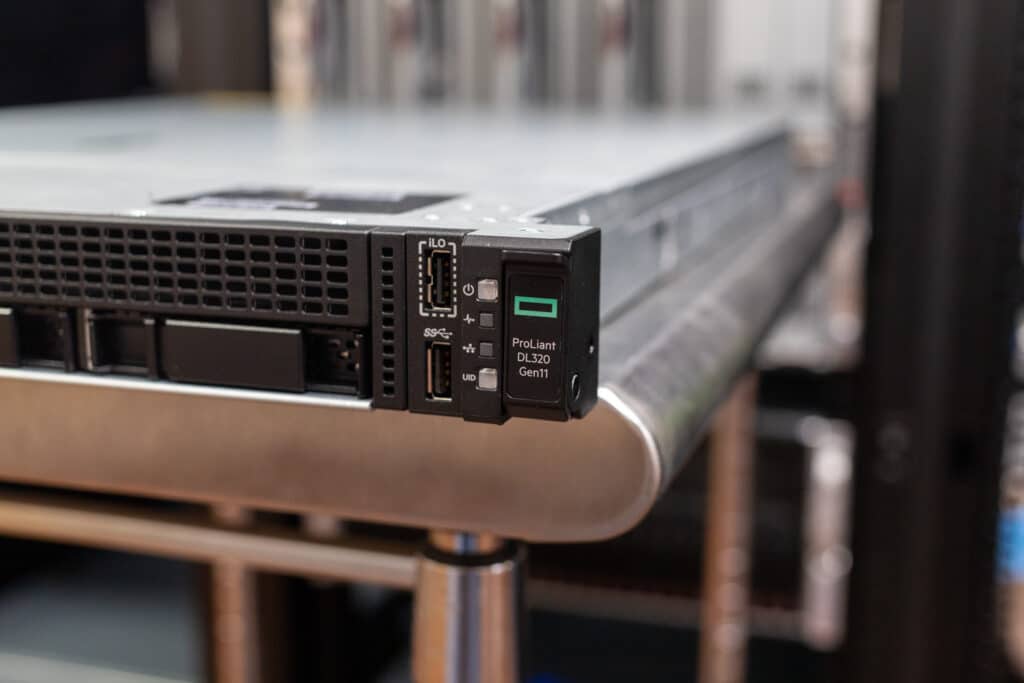
At its core, the DL320 Gen11 supports Intel Xeon processors with up to 32 cores. This server is further complemented by 16 DDR5 DIMM slots and 80x PCIe Gen5 lanes, laying the foundation for a system that not only meets the diverse needs of today’s businesses but does so with an eye on future scalability and performance.
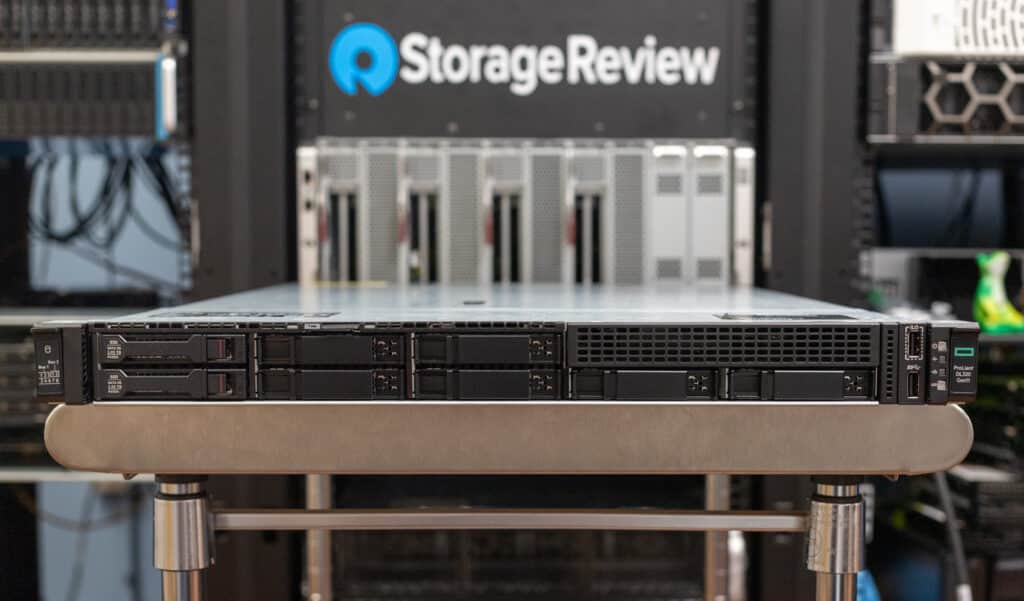
At the heart of the DL320 Gen11 is the power of 4th Gen Intel Xeon Scalable Processors, supporting up to 32 cores and 270W. This robust processing capability is complemented by a memory capacity of up to 2TB at 4800 MT/s and high-speed PCIe Gen5 slots, which accommodate up to four single-wide GPUs or two double-wide GPUs. This configuration positions the DL320 Gen11 as a potent yet cost-effective solution, ideal for performance-intensive applications in a compact 1U form factor.
The back panel layout for all HPE ProLiant DL320 Gen11 configurations is uniformly designed for consistency and ease of use. It features Slot-1 & 2 PCIe5 x16 FHHL for primary and secondary risers, a UID Indicator LED for easy server identification, and an optional NS204i-u Boot Device for enhanced boot capabilities. The NS204i-u holds two m.2 SSDs, offering a hot-swap redundant boot storage. For connectivity, there are two USB 3.2 Gen1 ports alongside two hot-plug power supplies for reliable power management.
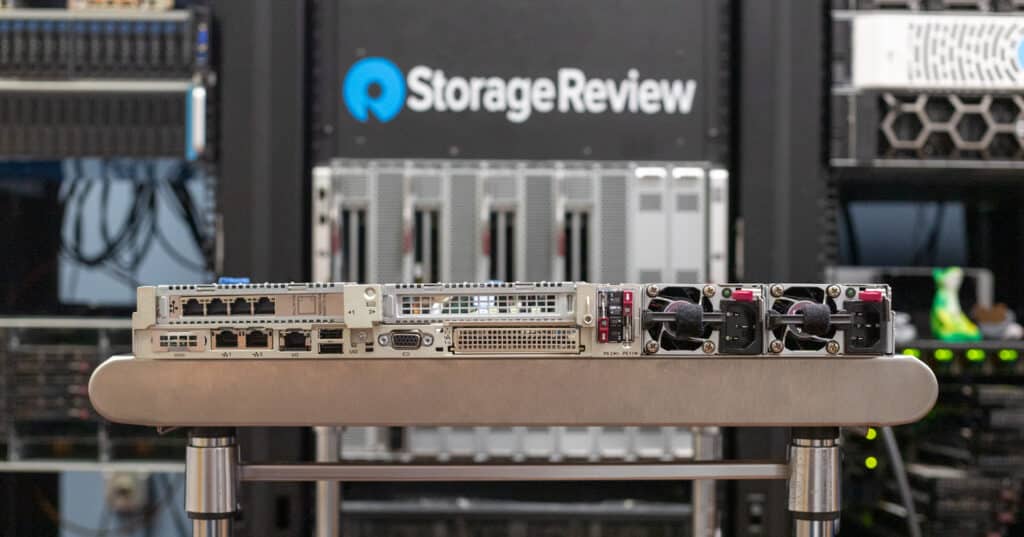
A dedicated iLO management port is included for advanced server management and diagnostics, while an OCP 3.0 Slot adds further expandability. An embedded 1×2 network port facilitates network connectivity, and additional interfaces include a Video (VGA) port for local display and an optional Serial port for legacy peripherals or other connectivity needs.
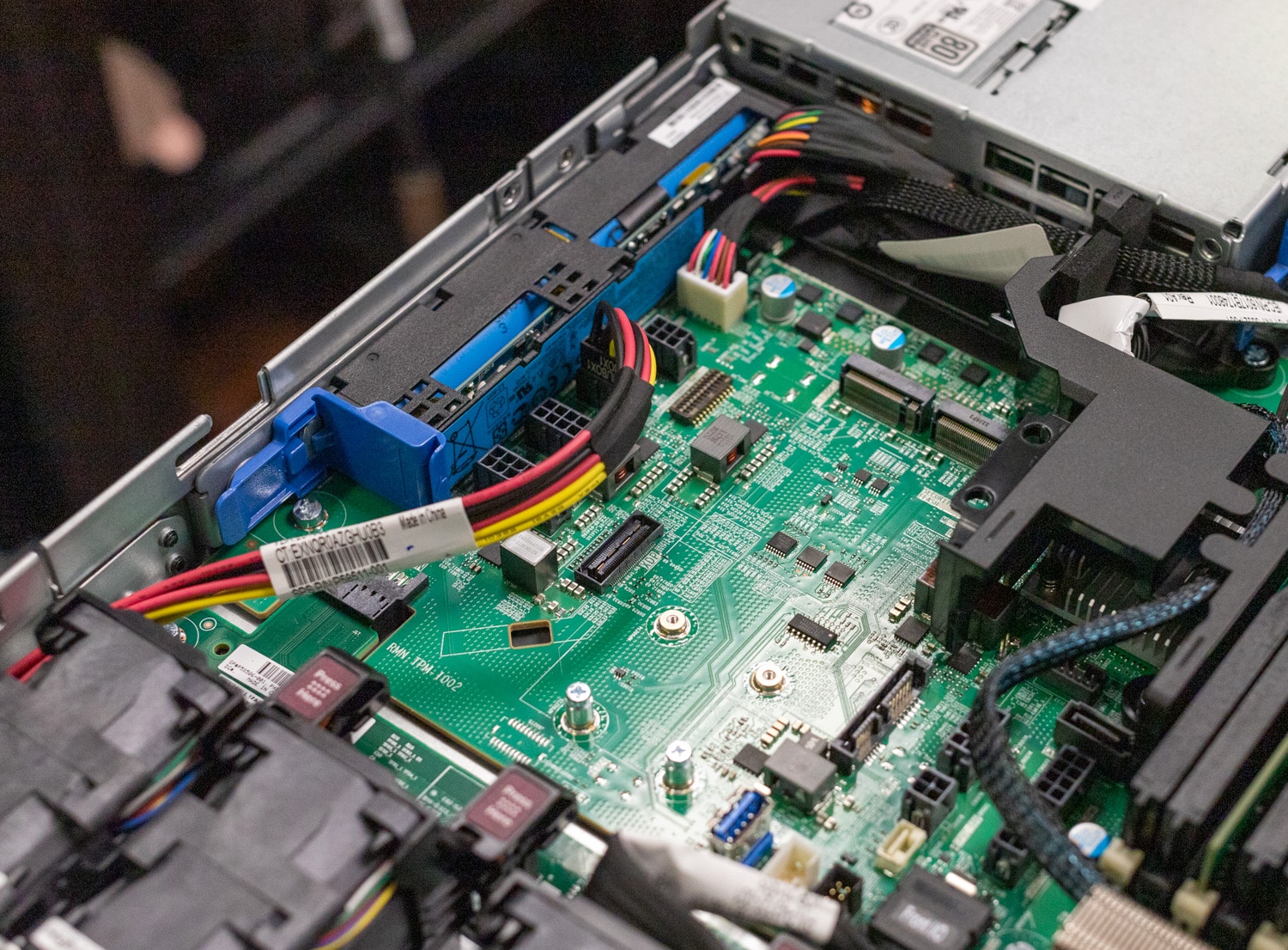
Internally, the HPE ProLiant DL320 houses two M.2 module connectors (not visible), offering flexible options for additional SSDs. The server’s expandability is further emphasized with two PCIe5 x16 Full-Height, Half-Length (FHHL) slots (primary and secondary risers), allowing for expansion and customization.
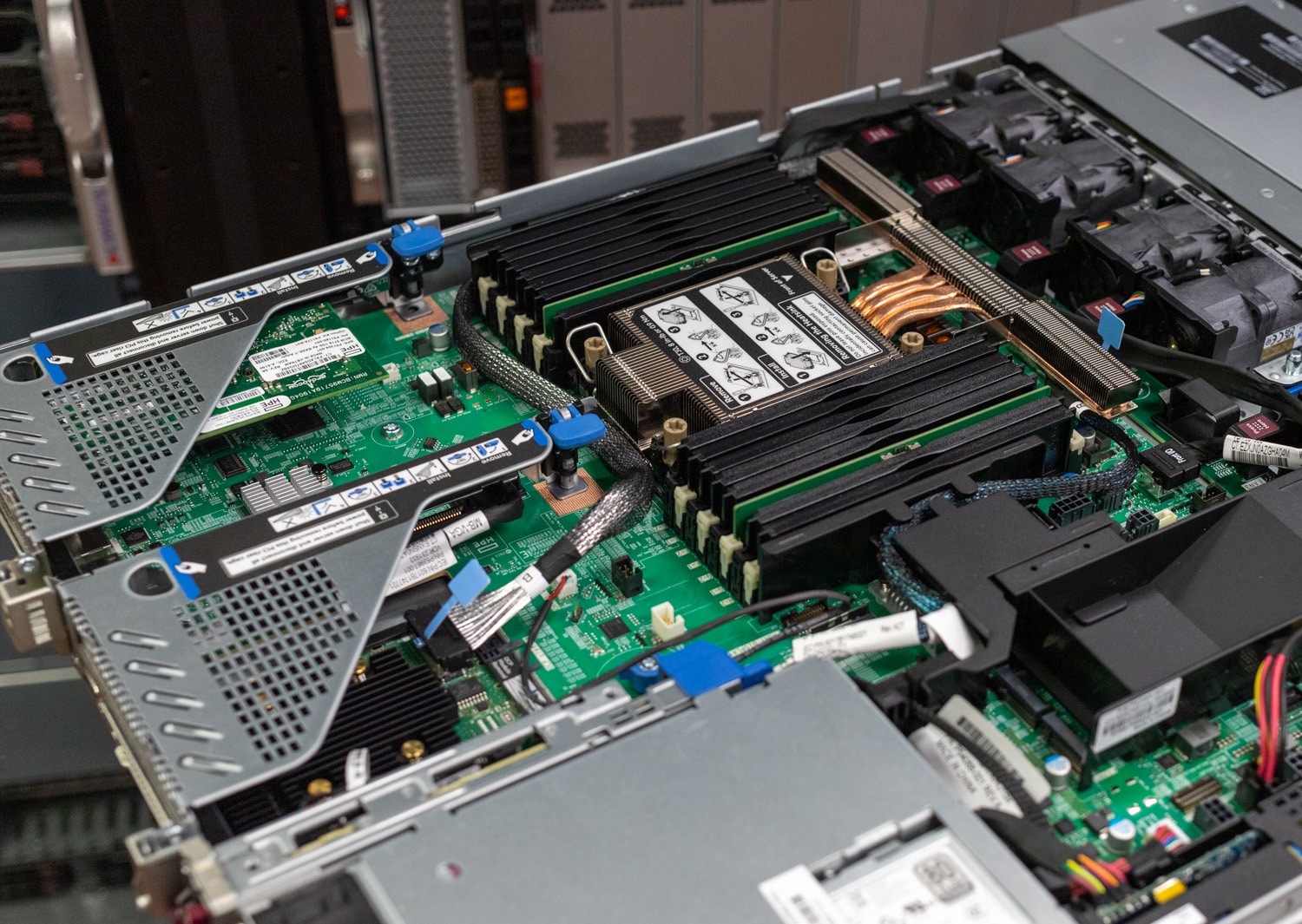
Like its other Gen11 counterparts, the DL320 is engineered for hybrid environments, offering simplicity in managing compute resources from the edge to the cloud. Including HPE GreenLake for Compute Ops Management enhances this experience by delivering a simplified, as-a-service compute management platform.
HPE ProLiant DL320 Gen11 CPU Model Support
The CPU models supported by the DL320 Gen11 range from Intel’s 4th Gen Xeon CPUs, such as Bronze for efficiency and cost-effectiveness, to Gold for higher performance, underscoring the server’s adaptability to various business needs and budget constraints. The DL360 Gen11’s use of higher-end Silver and Gold processors underlines its suitability for demanding data center environments, where maximum performance and scalability are paramount.
Let’s delve deeper into the HPE ProLiant DL320 Gen11 CPU offerings, showcasing the breadth and depth of its processing capabilities across various tiers.
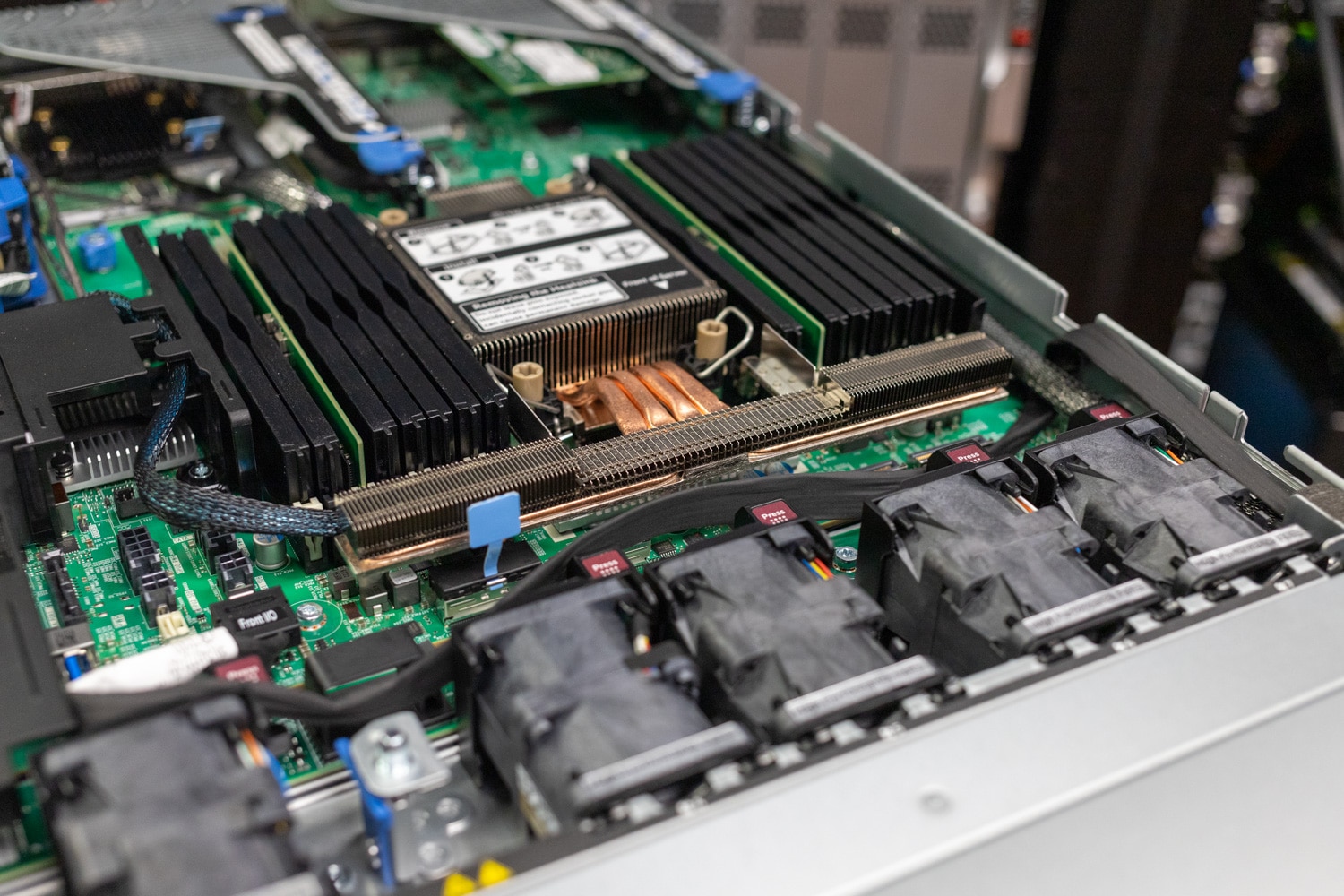
At the entry level, the lineup features the Intel Xeon-Bronze 3408U, an 8-core processor with a 1.8 GHz base frequency, 125W power consumption, and 22.5 MB L3 cache. This processor is designed for energy efficiency and cost-effectiveness, making it ideal for basic computing tasks and environments where power consumption is a concern.
In the mid-range, the DL320 Gen11 offers several Intel Xeon-Silver processors, such as the 4410Y and 4416+. The 4410Y is a 12-core processor clocked at 2.0 GHz, with a 150W power draw and a 30 MB L3 cache, offering a balanced performance for mid-tier workloads. On the other hand, the 4416+ elevates the performance with its 20 cores, operating at the same 2.0 GHz but with a slightly higher power consumption of 165W and a 37.5 MB L3 cache, suitable for more intensive tasks within medium-sized business environments.
The high-end spectrum of the DL320 Gen11’s CPU range is where the server truly stands out, featuring a selection of Intel Xeon-Gold processors. These include models like the 5416S, a 16-core processor with a 2.0 GHz speed, a 150W power draw, and 30MB L3 cache, which is an excellent fit for demanding applications in SMBs, such as virtualization and database management. The offerings extend up to the 6454S, which features 32 cores, a clock speed of 2.2 GHz, a significant 270W power draw, and an impressive 60 MB L3 cache. This processor is tailored for the most demanding applications and can handle extensive data analytics, complex virtualization environments, and high-traffic web applications.
With each step up in processor tier, from Bronze to Silver and then to Gold, the DL320 Gen11 demonstrates an increasing ability to handle more complex, data-intensive, and concurrent tasks, offering businesses a wide range of options to match their specific performance needs and budget constraints. This wide array of CPU choices underscores the DL320 Gen11’s adaptability and readiness to support evolving business requirements while maintaining a balance between power, performance, and cost-effectiveness.
Here’s a full list of CPUs:
- 4th Generation Intel Xeon-Gold 6
- Intel Xeon-Gold 6426Y 2.5GHz 16-core 185W Processor
- Intel Xeon-Gold 6442Y 2.6GHz 24-core 225W Processor
- Intel Xeon-Gold 6448Y 2.1GHz 32-core 225W Processor
- Intel Xeon-Gold 6434 3.7GHz 8-core 195W Processor
- Intel Xeon-Gold 6444Y 3.6GHz 16-core 270W Processor
- Intel Xeon-Gold 6430 2.1GHz 32-core 270W Processor
- Intel Xeon-Gold 6438Y+ 2.0GHz 32-core 205W Processor
- Intel Xeon-Gold 6414U 2.0GHz 32-core 250W Processor
- Intel Xeon-Gold 6438N 2.0GHz 32-core 205W Processor
- Intel Xeon-Gold 6421N 1.8GHz 32-core 185W Processor
- Intel Xeon-Gold 6454S 2.2GHz 32-core 270W Processor
- 4th Generation Intel Xeon-Gold 5
- Intel Xeon-Gold 5415+ 2.9GHz 8-core 150W Processor
- Intel Xeon-Gold 5418Y 2.0GHz 24-core 185W Processor
- Intel Xeon-Gold 5420+ 2.0GHz 28-core 205W Processor
- Intel Xeon-Gold 5412U 2.1GHz 24-core 185W Processor
- Intel Xeon-Gold 5411N 1.9GHz 24-core 165W Processor
- Intel Xeon-Gold 5418N 1.8GHz 24-core 165W Processor
- Intel Xeon-Gold 5416S 2.0GHz 16-core 150W Processor
- 4th Generation Intel Xeon-Silver (64GB SGX Enclave)
- Intel Xeon-Silver 4410Y 2.0GHz 12-core 150W Processor
- Intel Xeon-Silver 4416+ 2.0GHz 20-core 165W Processor
- 4th Generation Intel Xeon-Bronze
- Intel Xeon-Bronze 3408U 1.8GHz 8-core 125W Processor
HPE ProLiant DL320 Gen11 – GPU/Storage Variants
There are several different physical configurations of the DL320 Gen11, providing flexibility for customers to tune their storage and expansion options for their workload.
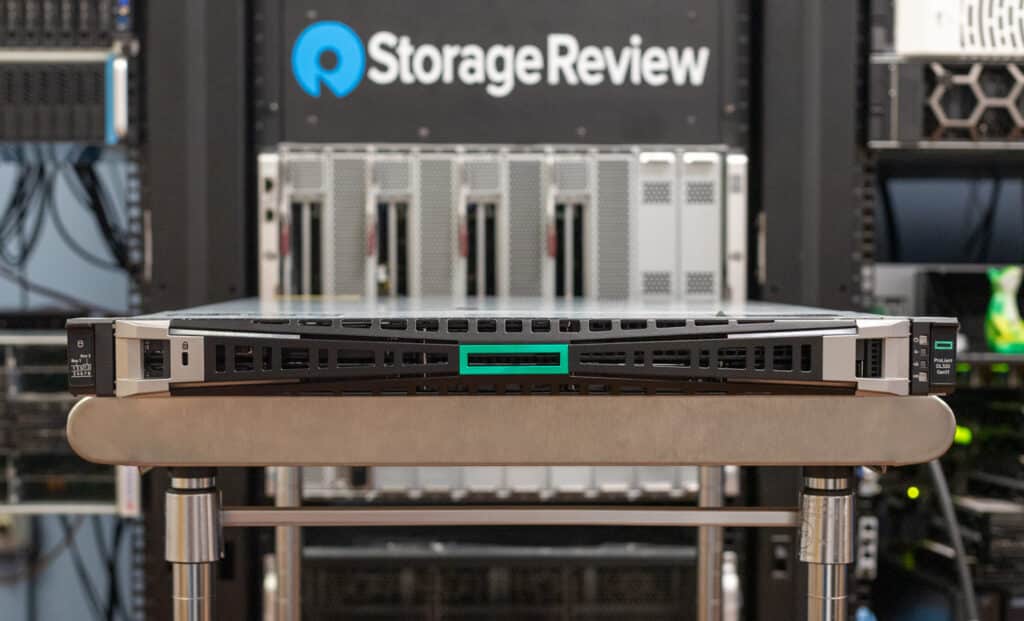
Our standard review model supports 8 +2 2.5″ drives with a few different backplane options. HPE also offers the server with a 4x 3.5″ HDD configuration for use cases that need capacity over performance. Both of these are pretty standard offerings in this category. But then HPE gets a little wild.
They offer a 12x HDD version of the DL320 Gen11, something not typically seen in an entry server. The 12x LFF drive cage is arranged in a 3×4 row layout. This substantial drive cage offers a significant increase in storage capacity suitable for data-intensive applications. This version of the server is a bit longer to accommodate the depth needed to house the hard drives.
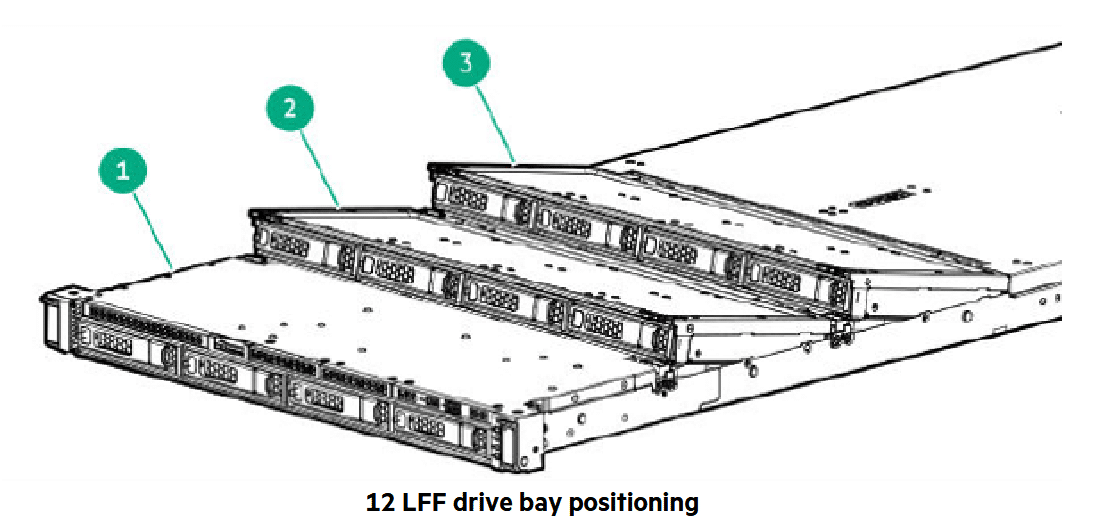
HPE also offers GPU server configurations with the DL320 Gen11. HPE supports up to four single- or two double-wide GPUs in the front cage with the GPU CTO server. This means customers could configure the server with four NVIDIA L4 GPUs or two NVIDIA L40 GPUs, for instance, to have a very cost-effective inferencing machine for edge use cases.
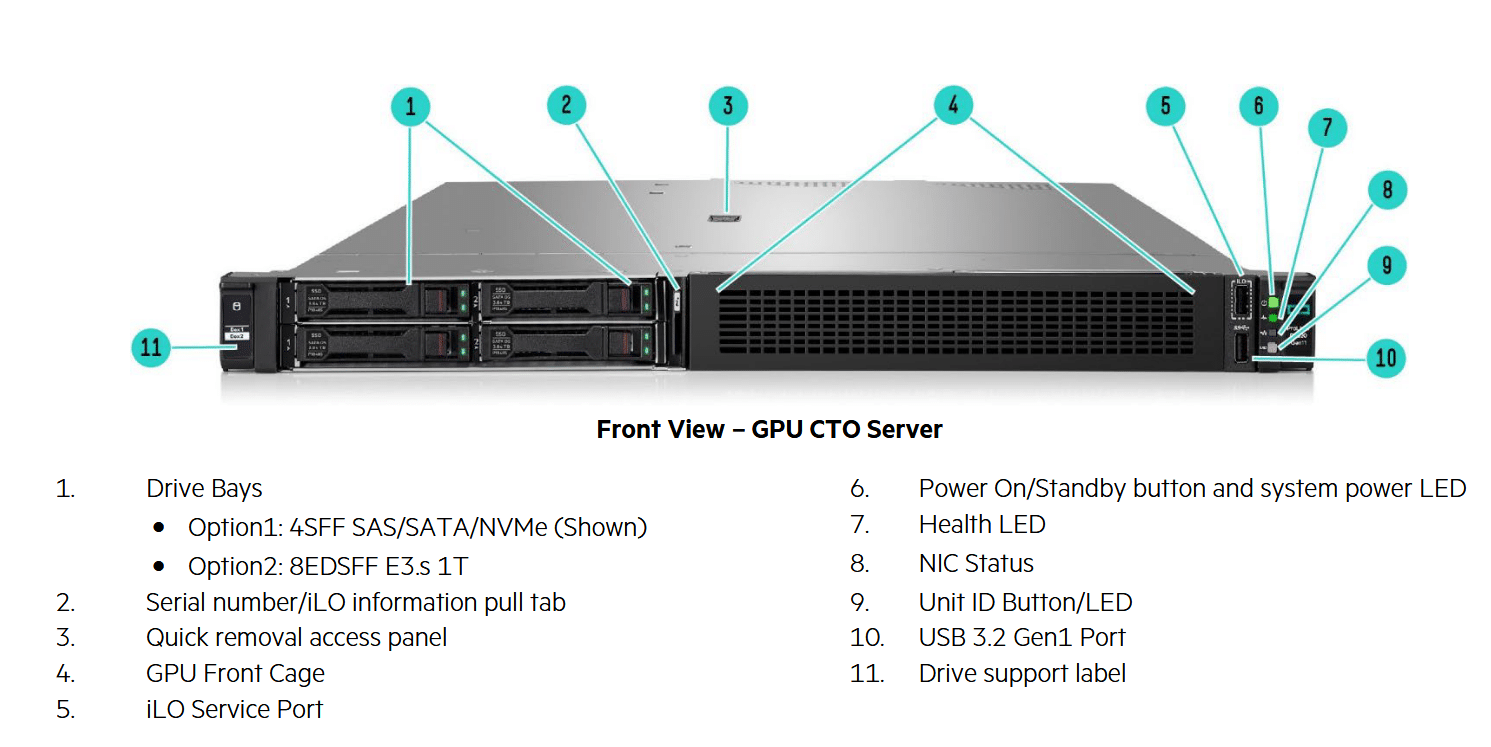
Additionally, a configuration option for the GPU variant of the DL320 Gen11 allows for eight E3.S SSDs, swapping out the 4x U.3 storage chassis.
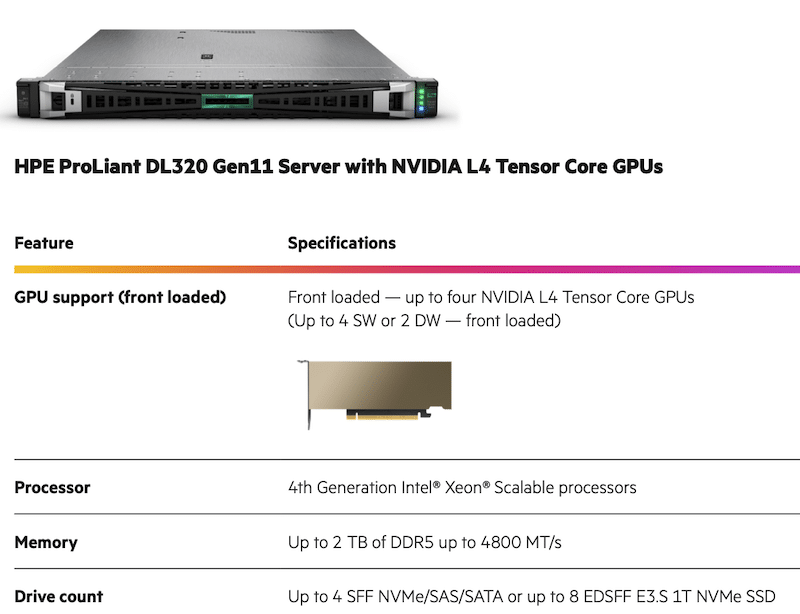
HPE ProLiant DL320 Gen11 Management – iLO 6
The DL320 Gen11 features a suite of advanced management capabilities through the integration of iLO 6, HPE’s latest version of its Lights-Out technology. iLO 6 brings a range of benefits (such as remote server setup, health monitoring, and power and thermal control) that enhance the manageability, security, and efficiency of the DL320 and simplify complex IT environments. While iLO isn’t new and is commonly found on most HPE servers, we note it here because it’s a tremendous value-add for those who may not be used to this depth of server management within this particular price band.
iLO’s advanced security features are designed to protect against threats and ensure data integrity while offering a streamlined interface and improved automation capabilities to facilitate a more intuitive user experience. Ultimately, it will reduce the time and effort required for various management tasks and make your life easier as an administrator.
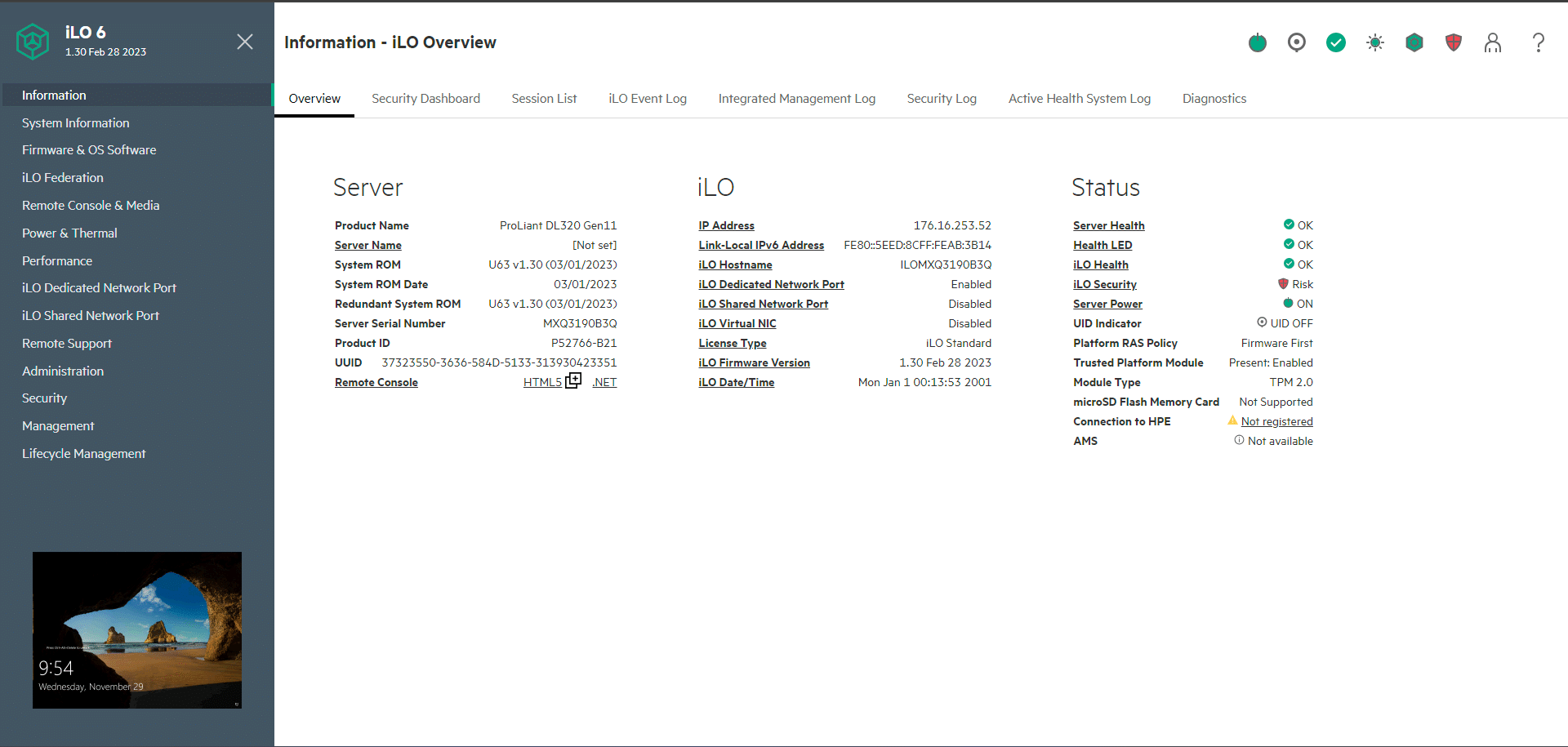
To improve the security of your DL320, iLO 6 incorporates HPE’s exclusive silicon root of trust, ensuring that only HPE-signed firmware boots to establish a secure foundation from the start. This security is further strengthened by HPE Secure Start, which authenticates firmware through this silicon root of trust to ensure that the booted firmware is safe and secure. HPE iLO 6 also enforces the use of cryptography and algorithms compliant with Commercial National Security Algorithm (CNSA) standards and introduces support for 2-factor authentication via PIV/CAC cards.
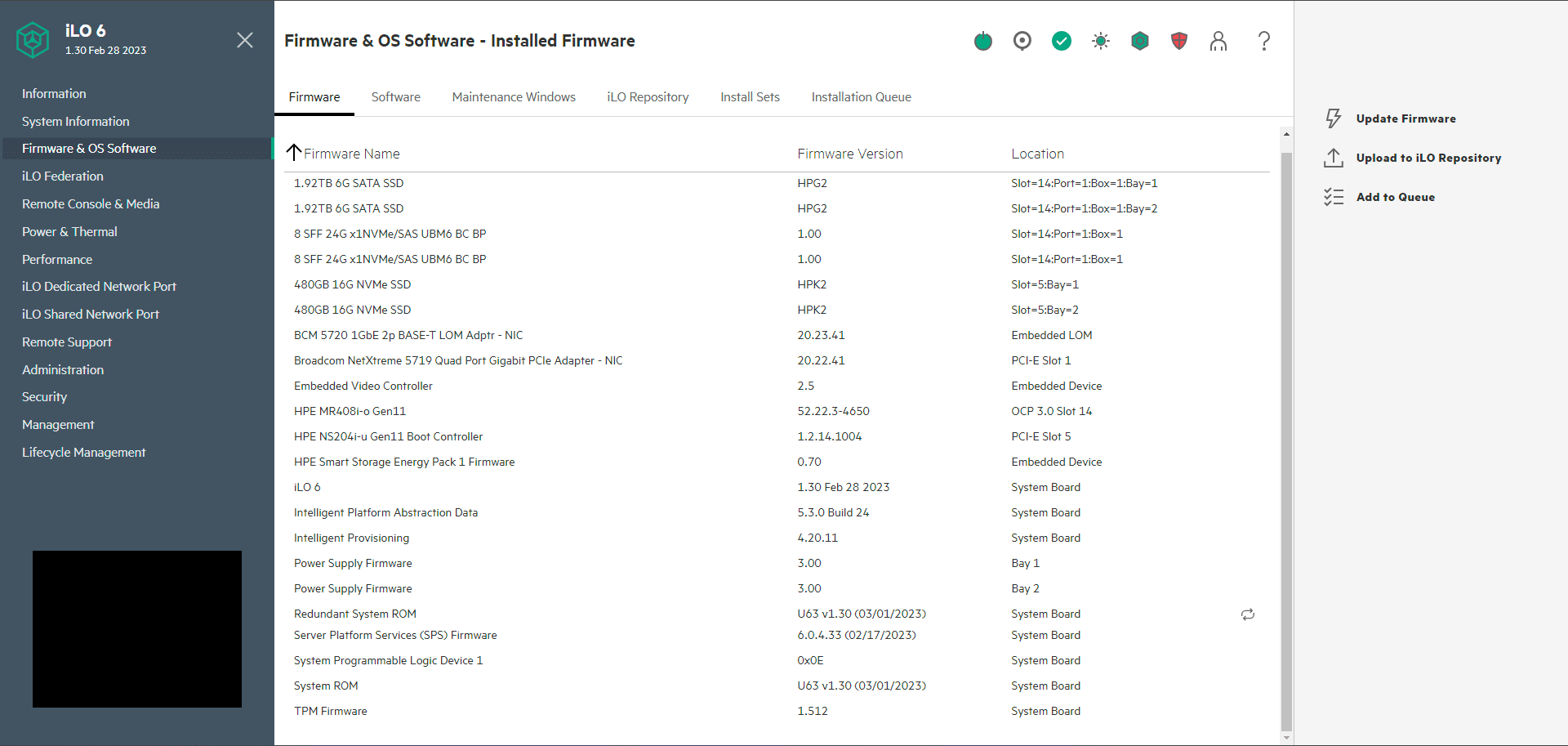
iLO 6’s Runtime Firmware Verification also regularly checks essential firmware to detect post-boot intrusions. If it detects a breach, it enables quick restoration of firmware to the factory or the last known safe settings to help minimize potential damage from the intruder.
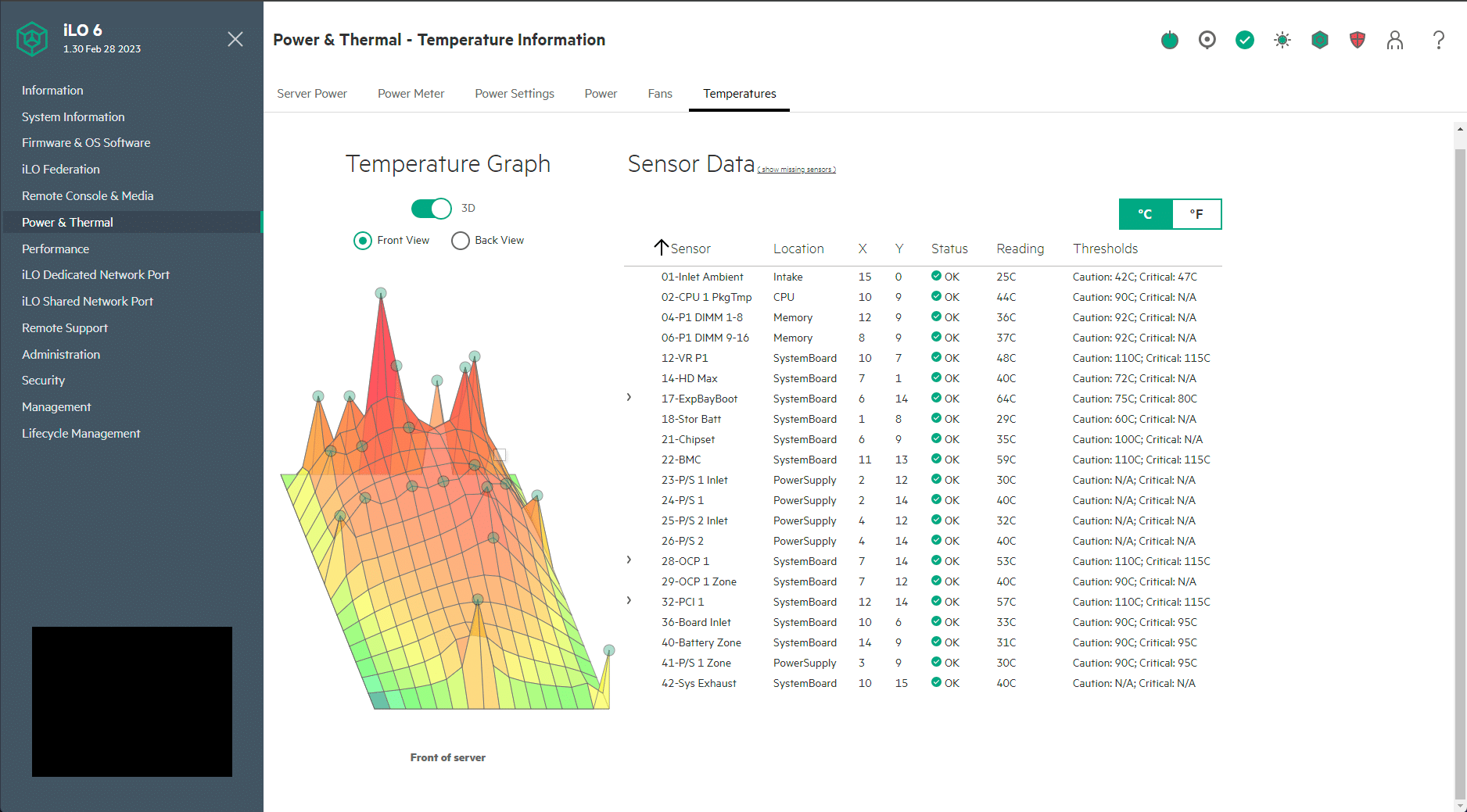
HPE ProLiant DL320 Gen11 Full Specifications
| Specification | Details |
| Processor Type | Intel |
| Processor Family | 4th Gen Intel Xeon Scalable Processors |
| Processor Models |
|
| Processor Number | 1 |
| Processor Core Available | 8 to 32 core, depending on the processor |
| Processor Cache | 26.25 – 60 MB L3, depending on processor |
| Processor Speed | Up to 3.7 GHz, depending on the processor |
| Power Supply Type | HPE Flex Slot Power Supplies (options vary: 500W, 800W, 1000W, 1600W, 1800-2000W) |
| Expansion Slots | Maximum, 2 PCIe Gen5 & 1 OCP 3.0 PCIe Gen5 |
| Maximum Memory | 2.0 TB per socket, one socket only, when populated with 128 GB DDR5 Memory. |
| Memory Slots | 16 DIMM slots per socket |
| Memory Type | HPE DDR5 Smart Memory |
| Memory Protection Features | HPE Fast Fault Tolerant Memory Advanced ECC, Online Spare, Mirrored Memory |
| Optical Drive Type | Optional HPE 9.5mm SATA DVD-RW Optical Drive, HPE Mobile USB DVD-RW Drive |
| System Fan Features | Standard or High-Performance Fan Kit, depending on model |
| Network Controller | Wide range of options (PCIe stand-up adapter and OCP3.0) |
| Storage Controller | Embedded SATA controller (AHCI or Intel SATA software RAID), Optional – HPE Smart Array Gen11 Controller |
| DIMM Capacity | 16 GB to 256 GB |
| Infrastructure Management | HPE GreenLake for Compute Ops Management, HPE iLO Standard, HPE OneView Standard, Optional – HPE iLO Advanced, HPE OneView Advanced |
| Warranty | 3/3/3: Three years of parts, labor, and onsite support coverage. Additional coverage is available. |
| Drive Supported | Up to 8+2 SFF SAS/SATA HDDs or SATA/SAS/NVMe U.2 or U.3 SSDs, depending on the model |
HPE ProLiant DL320 Gen11 vs DL360 Gen11
With multiple 1U Intel servers in the portfolio, comparing the available configurations of the HPE ProLiant DL320 Gen11 and the DL360 Gen11 servers reveals distinct differences tailored to different use cases and performance needs. The most obvious difference is the CPU choice. The DL320 Gen11 tops out at 32-core CPUs, and the DL360 Gen 11 offers two CPUs and scales to Intel’s top processor.
The DL320 Gen11 offers lower base memory configurations: 2TB per socket (one socket only) when each 16 DIMMS is populated with 128GB DDR5 memory sticks. This highlights its adaptability to both budget-friendly and more demanding scenarios. The DL360 Gen11 doubles this memory total to 4TB per socket when populated with 256GB DDR5 RAM sticks.
The DL320 Gen11’s PCIe configurations, typically one Gen5 and one OCP 3.0 Gen5 slot, cater to businesses needing moderate expandability, perhaps for additional network cards or reasonable external storage. The DL360 Gen11 goes further, offering more expansion slots. This indicates a design catering to environments where high-speed I/O and extensive external connectivity are crucial, similar to clustered computing or high-speed storage networks.
The DL320 Gen11’s storage capabilities, which support a mix of SFF and LFF drives, suggest versatility, catering to a range of storage requirements from high-speed SSDs to larger-capacity HDDs. The DL360 Gen11’s storage controllers, such as the HPE MR408i-o Gen11, focus on high-performance storage solutions to support more data-intensive applications.
HPE ProLiant DL320 Gen11 Performance
Our HPE ProLiant DL320 Gen11 server build showcases a basic configuration tailored for SMBs. As such, we don’t expect a lot in the way of performance during our benchmarking. That said, many tasks where these servers are deployed aren’t particularly intensive, so the performance data is instructive for scale.
At its core, our review DL320 Gen11 features the 32-core Intel Xeon-G 6430 CPU and 32GB of DDR5 RAM (via two 16GB sticks) and includes two 1.92TB SATA RI SFF BC MV SSDs. It also has two 800W FS Platinum Hot-Plug LH PSUs for reliable and efficient power delivery.
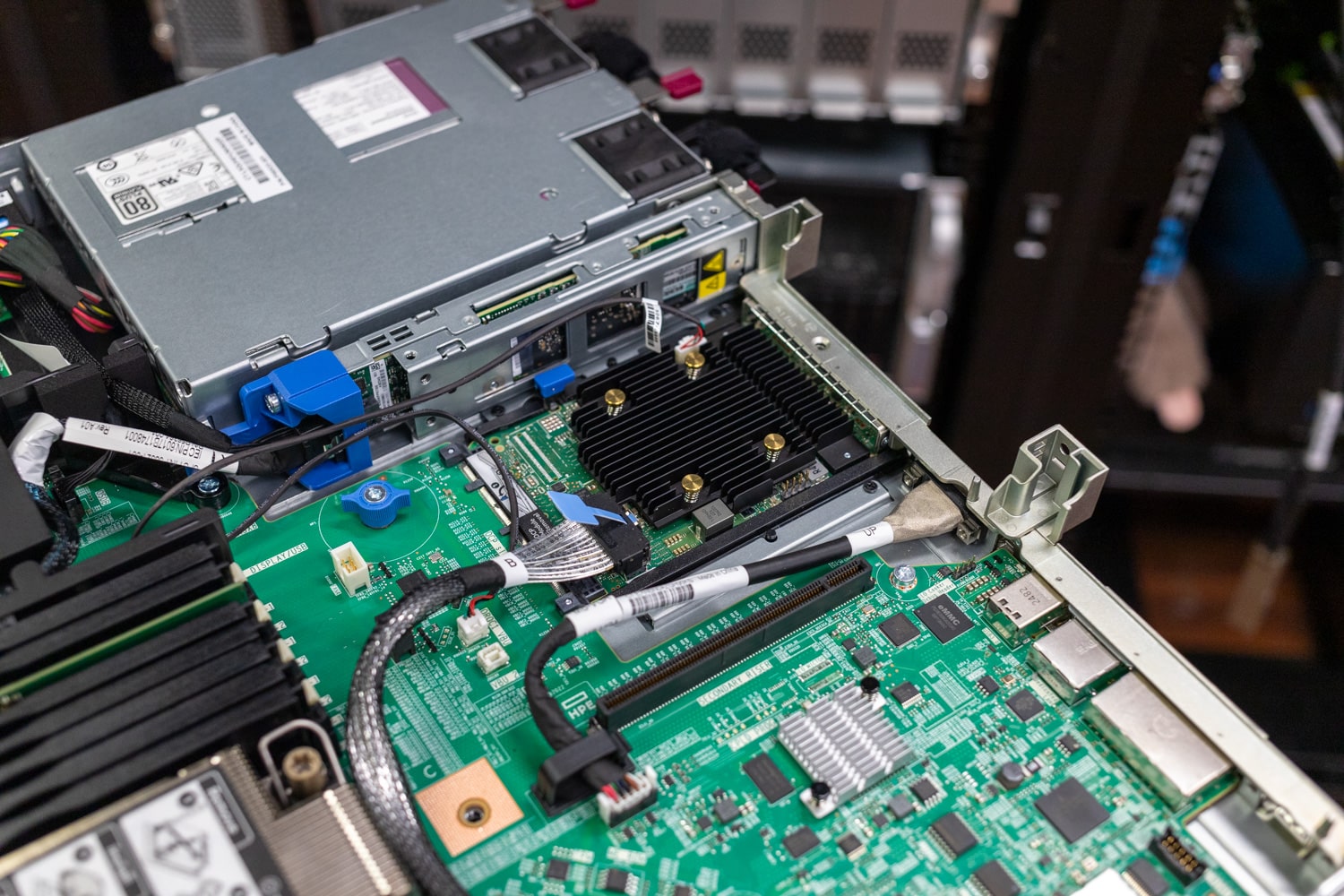
Rounding off the build is an HPE MR408i-o Gen11 SPDM Storage Controller, which provides RAID support, enhanced data protection, and a 1Gb 4-Port BASE-T Adapter to handle network activity.
The server lacks a GPU and is light on DRAM in its configuration, so we have tailored our benchmarking approach to focus on tests that heavily leverage CPU capabilities, which means we won’t conduct benchmarks such as ESRI, Luxmark, SPECworkstation 3, 7zip, and SPECviewperf 2020. Instead, our evaluation will concentrate on benchmarks that primarily stress the CPU to clearly show its performance in compute-intensive tasks.
Blender OptiX
First up is the Blender test–an open-source 3D modeling application. This benchmark was run using the Blender Benchmark utility. The score is samples per minute, with higher being better.
| HPE ProLiant DL320 (Intel 4th Gen Xeon-G 6430 CPU (32 cores, 3.7 GHz max)) | |
| Blender OptiX Version 3.6 (CPU) (Samples per minute; Higher is better) |
Score |
| Monster | 279 |
| Junkshop | 177 |
| Classroom | 135 |
In the benchmark tests for version 3.5 of Blender, the HPE ProLiant DL320 achieved varying results across different rendering scenarios with its Intel 4th Gen Xeon-G 6430 processor. For the ‘Monster’ scene, it recorded a score of 279 samples per minute. The ‘Junkshop’ scene (which involves a moderate level of detail and complexity) yielded a score of 177 samples per minute. Lastly, in the ‘Classroom’ scene, which might be the most demanding of the three due to intricate details and more lighting calculations, the server scored 135 samples per minute. These results demonstrate that it isn’t meant for complex rendering tasks as configured.
| HPE ProLiant DL320 (Intel 4th Gen Xeon-G 6430 CPU (32 cores, 3.7 GHz max)) | |
| Blender OptiX Version 4.0 (CPU) (Samples per minute; Higher is better) |
|
| Monster | 952 |
| Junkshop | 613 |
| Classroom | 437 |
In version 4.0 of Blender, the HPE ProLiant DL320 delivered improved results, showing 952 samples per minute for the ‘Monster’ scene, 613 for ‘Junkshop,’ and 437 for ‘Classroom.’
Blackmagic RAW Speed Test
We have also started running Blackmagic’s RAW speed test, which tests video playback performance. Additionally, this test is more of a hybrid test pooling both CPU and GPU in a Real-World scenario for RAW decoding.
| Blackmagic RAW Speed Test (Higher is better) | HPE ProLiant DL320 (Intel 4th Gen Xeon-G 6430 CPU, 32 cores, 3.7 GHz max) |
| 8K CPU | 99 FPS |
| 8K CUDA | N/A |
The HPE ProLiant DL320 demonstrated decent performance in the Blackmagic RAW Speed Test. In video playback and RAW decoding scenarios, it achieved 99 FPS in the 8K CPU test, indicating that it can handle some high-resolution video processing efficiently. As we do not have a GPU in this build, we did not evaluate the 8K CUDA portion of this test.
Geekbench 6
Geekbench 6 is a cross-platform benchmark that measures overall system performance. However, looking at the single-core vs. multi-core and the OpenCL benchmark would be interesting. Higher scores are better. Again, we only looked at the CPU results, as no GPU is installed inside this server.
You can find comparisons to any system you want in the Geekbench Browser.
| Geekbench 6 | HPE ProLiant DL320 (Intel 4th Gen Xeon-G 6430 CPU, 32 cores, 3.7 GHz max) |
| CPU Benchmark – Single-Core | 1,732 |
| CPU Benchmark – Multi-Core | 12,792 |
| GPU Benchmark – OpenCL | N/A |
Cinebench R23
Maxon’s Cinebench R23 is a CPU rendering benchmark that utilizes all CPU cores and threads. We ran it for both multi- and single-core tests. Higher scores are better.
| Cinebench R23 | HPE ProLiant DL320 (Intel 4th Gen Xeon-G 6430 CPU, 32 cores, 3.7 GHz max) |
| CPU (Multi-Core) (Points) | 38,707 |
| CPU (Single-Core) (Points) | 1,245 |
| MP Ratio | 31.10x |
Cinebench 2024
Here are the results for the 2024 version of Cinebench, looking at the CPU and GPU performance.
| Cinebench R23 | HPE ProLiant DL320 (Intel 4th Gen Xeon-G 6430 CPU, 32 cores, 3.7 GHz max) |
| CPU (Multi-Core) (Points) | 2,014 |
| CPU (Single-Core) (Points) | 71 |
| MP Ratio | 28.29x |
y-cruncher
y-cruncher is a multi-threaded and scalable program that can compute Pi and other mathematical constants to trillions of digits. Since its launch in 2009, y-cruncher has become a popular benchmarking and stress-testing application for overclockers and hardware enthusiasts. Faster is better in this test.
| y-cruncher (Total Computation time) | |
| 1 billion digits (Seconds) | 21.452 |
| 2.5 billion digits (Seconds) | 50.418 |
| 10 billion digits (Seconds) | 131.135 |
The y-cruncher benchmark results, while indicating performance limitations of the low-end build, can still be relevant for small and medium-sized businesses (SMBs) in specific contexts. This type of system could be quite adequate for SMBs whose computing needs are not centered on high-intensity computational tasks.
Conclusion
The HPE ProLiant DL320 Gen11 is a highly adaptable and efficient 1U 1P server, given the proper configuration, crafted to meet the evolving requirements of edge AI workloads, ROBO (Remote Office/Branch Office) environments, and SMB applications.
At its core lies a single 4th Gen Intel Xeon Scalable Processor, supporting up to 32 cores and 270W, alongside a memory capacity of up to 2TB at 4800 MT/s and PCIe Gen5 slots. HPE also offers a few interesting configurations, including one that supports a dozen HDDs and another with 4x NVIDIA L4 GPU support, which is great for inferencing.
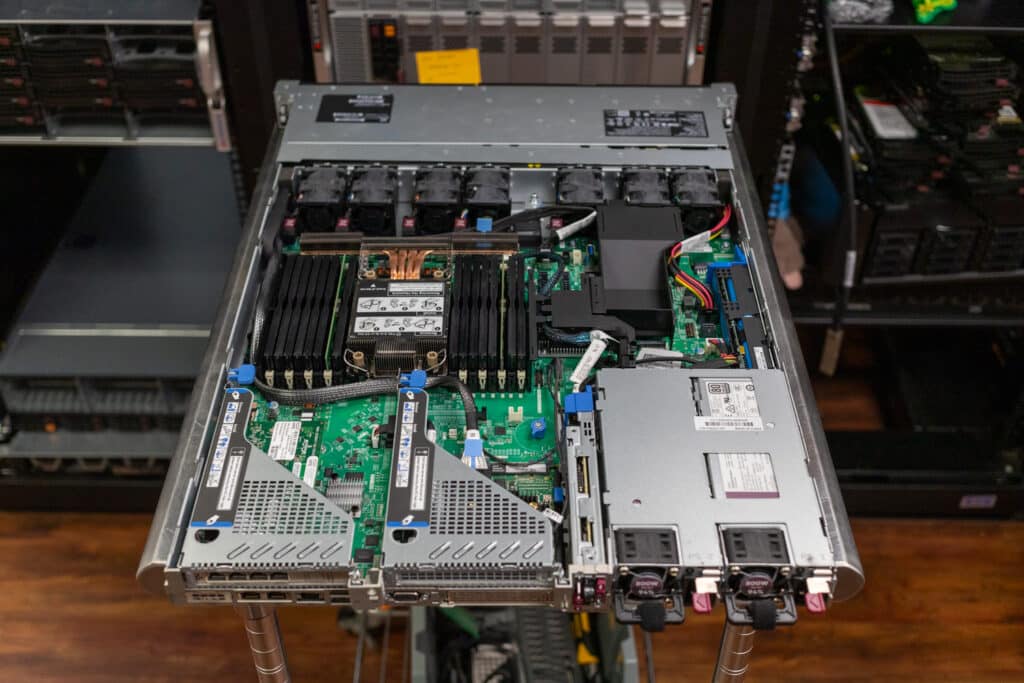
Based on our lighter review configuration, The DL320 Gen11 showed modest performance in benchmarks. Although the absence of a GPU and larger DRAM footprint restricted our testing scope, the server demonstrated adequate capability for handling compute-intensive tasks, aligning well with the expectations for a budget-conscious build suitable for SMBs with moderate computing needs.
The DL320 Gen11 has a lot of potential with its flexibility in processor options and expansion capabilities. SMBs will be able to tailor a solution that meets their specific performance requirements and budgetary constraints, making the DL320 Gen11 a versatile and scalable solution for a wide array of scenarios.




 Amazon
Amazon